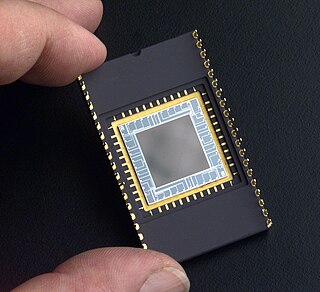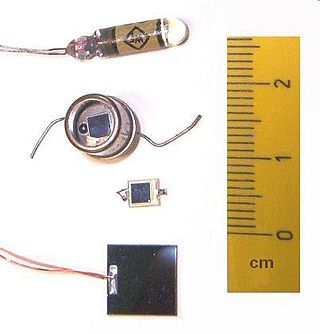
A charge-coupled device (CCD) is an integrated circuit containing an array of linked, or coupled, capacitors. Under the control of an external circuit, each capacitor can transfer its electric charge to a neighboring capacitor. CCD sensors are a major technology used in digital imaging.

A photodiode is a semiconductor diode sensitive to photon radiation, such as visible light, infrared or ultraviolet radiation, X-rays and gamma rays. It produces an electrical current when it absorbs photons. This can be used for detection and measurement applications, or for the generation of electrical power in solar cells. Photodiodes are used in a wide range of applications throughout the electromagnetic spectrum from visible light photocells to gamma ray spectrometers.

A digital camera, also called a digicam, is a camera that captures photographs in digital memory. Most cameras produced today are digital, largely replacing those that capture images on photographic film or film stock. Digital cameras are now widely incorporated into mobile devices like smartphones with the same or more capabilities and features of dedicated cameras. High-end, high-definition dedicated cameras are still commonly used by professionals and those who desire to take higher-quality photographs.

A webcam is a video camera which is designed to record or stream to a computer or computer network. They are primarily used in video telephony, live streaming and social media, and security. Webcams can be built-in computer hardware or peripheral devices, and are commonly connected to a device using USB or wireless protocol.

High-speed photography is the science of taking pictures of very fast phenomena. In 1948, the Society of Motion Picture and Television Engineers (SMPTE) defined high-speed photography as any set of photographs captured by a camera capable of 69 frames per second or greater, and of at least three consecutive frames. High-speed photography can be considered to be the opposite of time-lapse photography.

An image sensor or imager is a sensor that detects and conveys information used to form an image. It does so by converting the variable attenuation of light waves into signals, small bursts of current that convey the information. The waves can be light or other electromagnetic radiation. Image sensors are used in electronic imaging devices of both analog and digital types, which include digital cameras, camera modules, camera phones, optical mouse devices, medical imaging equipment, night vision equipment such as thermal imaging devices, radar, sonar, and others. As technology changes, electronic and digital imaging tends to replace chemical and analog imaging.
The following are common definitions related to the machine vision field.

An active-pixel sensor (APS) is an image sensor, which was invented by Peter J.W. Noble in 1968, where each pixel sensor unit cell has a photodetector and one or more active transistors. In a metal–oxide–semiconductor (MOS) active-pixel sensor, MOS field-effect transistors (MOSFETs) are used as amplifiers. There are different types of APS, including the early NMOS APS and the now much more common complementary MOS (CMOS) APS, also known as the CMOS sensor. CMOS sensors are used in digital camera technologies such as cell phone cameras, web cameras, most modern digital pocket cameras, most digital single-lens reflex cameras (DSLRs), mirrorless interchangeable-lens cameras (MILCs), and lensless imaging for, e.g., blood cells.

In digital imaging, a color filter array (CFA), or color filter mosaic (CFM), is a mosaic of tiny color filters placed over the pixel sensors of an image sensor to capture color information.

A projection keyboard is a form of computer input device whereby the image of a virtual keyboard is projected onto a surface: when a user touches the surface covered by an image of a key, the device records the corresponding keystroke. Some connect to Bluetooth devices, including many of the latest smartphone, tablet, and mini-PC devices with Android, iOS or Windows operating system.
OmniVision Technologies Inc. is an American subsidiary of Chinese semiconductor device and mixed-signal integrated circuit design house Will Semiconductor. The company designs and develops digital imaging products for use in mobile phones, laptops, netbooks webcams, security, entertainment, automotive and medical imaging systems. Headquartered in Santa Clara, California, OmniVision Technologies has offices in the US, Western Europe and Asia.

Exmor is a technology developed by Sony and implemented on some of their CMOS image sensors. It performs on-chip analog/digital signal conversion and two-step noise reduction in parallel on each column of the CMOS sensor.
ZCam is a brand of time-of-flight camera products for video applications by Israeli developer 3DV Systems. The ZCam supplements full-color video camera imaging with real-time range imaging information, allowing for the capture of video in 3D.

A time-of-flight camera, also known as time-of-flight sensor, is a range imaging camera system for measuring distances between the camera and the subject for each point of the image based on time-of-flight, the round trip time of an artificial light signal, as provided by a laser or an LED. Laser-based time-of-flight cameras are part of a broader class of scannerless LIDAR, in which the entire scene is captured with each laser pulse, as opposed to point-by-point with a laser beam such as in scanning LIDAR systems. Time-of-flight camera products for civil applications began to emerge around 2000, as the semiconductor processes allowed the production of components fast enough for such devices. The systems cover ranges of a few centimeters up to several kilometers.
Sony Depthsensing Solutions SA/NV, formerly known as SoftKinetic Systems, is a Belgian company originating from the merger of Optrima NV, founded by André Miodezky, Maarten Kuijk, Daniël Van Nieuwenhove, Ward Van der Tempel, Riemer Grootjans and Tomas Van den Hauwe and SoftKinetic SA founded by Eric Krzeslo, Thibaud Remacle, Gilles Pinault and Xavier Baele. Sony Depthsensing Solutions develops gesture recognition hardware and software for real-time range imaging (3D) cameras. SoftKinetic was founded in July 2007 providing gesture recognition solutions based on its technology to the interactive digital entertainment, consumer electronics, health & fitness, and serious game industries. SoftKinetic technology has been applied to interactive digital signage and advergaming, interactive television, and physical therapy.

PrimeSense was an Israeli 3D sensing company based in Tel Aviv. PrimeSense had offices in Israel, North America, Japan, Singapore, Korea, China and Taiwan. PrimeSense was bought by Apple Inc. for $360 million on November 24, 2013.
Project Digits is a Microsoft Research Project under Microsoft's computer science laboratory at the University of Cambridge; researchers from Newcastle University and University of Crete are also involved in this project. Project is led by David Kim, a Microsoft Research PhD and also a PhD student in computer science at Newcastle University. Digits is an input device which can be mounted on the wrist of human hand and it captures and displays a complete 3D graphical representation of the user's hand on screen without using any external sensing device or hand covering material like data gloves. This project aims to make gesture-controlled interfaces completely hands free with greater mobility and accuracy. It allows user to interact with whatever hardware while moving from room to room or walking down the street without any line of sight connection with the hardware.

InVisage Technologies is a fabless semiconductor company known for producing a technology called QuantumFilm, an image sensor technology that improves the quality of digital photographs taken with a cell phone camera. The company is based in Menlo Park, CA.

PMD Technologies is a developer of CMOS semiconductor 3D time-of-flight (ToF) components and a provider of engineering support in the field of digital 3D imaging. The company is named after the Photonic Mixer Device (PMD) technology used in its products to detect 3D data in real time. The corporate headquarters of the company is located in Siegen, Germany.

Google's Advanced Technology and Projects group (ATAP) is a skunkworks team and in-house technology incubator, created by former DARPA director Regina Dugan. ATAP is similar to X, but works on projects, granting project leaders time—previously only two years—in which to move a project from concept to proven product. According to Dugan, the ideal ATAP project combines technology and science, requires a certain amount of novel research, and creates a marketable product. Historically, the ATAP team was born at Motorola Mobility and kept when Google sold Motorola Mobility to Lenovo in 2014; for this reason, ATAP ideas have tended to involve mobile hardware technology.














